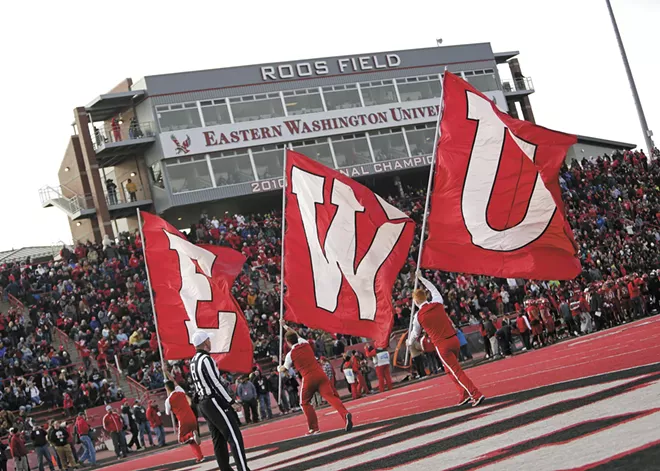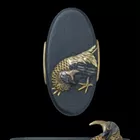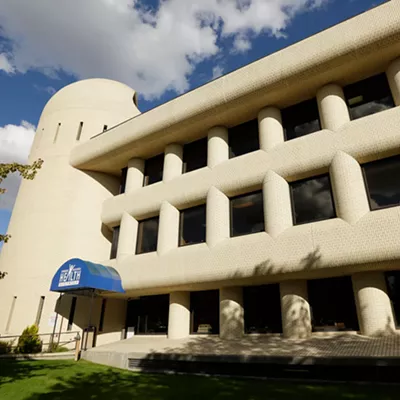
As Eastern Washington University works to become more financially sustainable and address a budget deficit, even the most celebrated aspects of the college are at risk of being cut.
Two reports released last week will guide the next potentially painful restructuring process. At a glance, there are some eyebrow-raising recommendations in the reports from two committees tasked with ranking every academic program and service at Eastern.
On the services side, not only are the student bookstore and on-campus dining options highlighted for "disinvestment," but the school's money-losing NCAA Division I football program is listed for "transformation."
On the academic side, 175 programs were selected for disinvestment. That's 40% of the school's academic offerings, although they make up only 20% of the overall academic costs.
The reports mark the end of a yearlong "strategic resource allocation" process that called on two 16-member committees made up of professors and university staff to rank everything the school offers into five "quintiles": invest, maintain, streamline, transform or disinvest.
The reports note that many of the programs in the bottom "disinvest" quintile could be maintained with some changes, such as combining similar majors or minors.
While there's no guarantee the school's Board of Trustees or administration will actually cut the programs in the "disinvest" group or will throw more money toward those in the "invest" group, the documents will guide university leaders looking to strengthen the bottom line.
For years, Eastern faculty have been calling on the school to look for financial savings in the athletics program rather than in the academic programs that serve the school's mission as an institution of higher education.
Though athletics is continually spending more money than it takes in — and was more than $3.1 million in the hole in fiscal 2022 — the Board of Trustees has been unwilling so far to consider dropping out of the Big Sky conference. Board members explicitly voted in June 2021 to remain in NCAA Division I.
Instead, with the university facing an expected budget gap between $10.5 million and $13 million for this fiscal year 2024, the board and university President Shari McMahan called on the campus community to look for ways to save money.
"Our students have chosen Eastern, and while it's comfortable to do what we've always done, we can't continue to do the same and expect different outcomes," McMahan told the board on Friday, Dec. 8.
340 ATHLETES, 10,700 STUDENTS
State money budgeted for the university cannot pay for athletics, especially football, as one of the reports noted.
"It is unsustainable for a university of our size with our budgetary challenges to allow a single unit to accumulate annual deficits as large as the ones listed," states the University Services Task Force report, released on Dec. 6. It recommends the idea of "moving football to a lower division."
Faculty have pointed out that about 20% of student tuition and fees end up funding athletics at Eastern. The university's budget office says the true number is actually 18%.
Either way, that's out of line with other regional state universities. In a July letter to President McMahan and Board of Trustees Chair Jay Manning, faculty leaders noted that Central Washington University and Western Washington University "dedicate closer to 4-5% of student tuition and fees to athletics."
In an August response, Manning said that while enrollment is declining and the university does need to look for savings everywhere, including in athletics, the board continues to believe its decision to remain in Division I is the right one. He also questioned comparing Eastern to Central and Western because those two have smaller, Division II athletics programs and larger student enrollment than Eastern.
"The benefits provided by our excellent athletic program justifies the ongoing investment," Manning wrote. "I know we disagree on that point and reasonable minds can certainly differ on such a judgment call."
But some faculty members don't feel those benefits have been spelled out sufficiently. About 340 of the more than 10,700 students are athletes.
David Syphers, who teaches physics and astronomy at Eastern, was the president of the Faculty Organization when many of the questions about athletics arose a few years ago. He and a few other professors published a report in February 2020 digging into the costs of the program. He's specifically asked the university to show how athletics helps drive enrollment or provides other benefits.
"We want to support all of our students. It's not their fault that we're having budget issues," Syphers says. "But we're trying to make sure we preserve the primary mission of the university, which is academics."
About a third of students at Eastern are first-generation college students and about a quarter are Pell Grant recipients with exceptional financial need. As much as $1,600 of a student's estimated $9,100 in yearly tuition and fees (for in-state students) goes to athletics.
They'd likely appreciate their tuition going toward investments in other services, such as mental health counseling and career advising, Syphers says.
"We need to be very thoughtful stewards of their money, and I don't think that's what's happening with athletics right now," he adds.
It's not completely clear how much money Eastern could save by joining another division, but it's likely in the millions if other schools are a model.
A February 2021 third-party report solicited by Eastern found that the median athletics loss for Division II schools was at least $7.7 million less than Eastern's athletics loss in 2019. None of the 127 Division I programs in the Football Championship Subdivision generated more revenue than expenses in 2019, according to the NCAA, with a median net negative of $14.3 million.
Thanks to a 2018 bill from state Senate Majority Leader Andy Billig, D-Spokane, Eastern and other state universities and colleges are required to maintain updated athletics financial information for the public. The Board of Trustees or Regents must also approve a plan to reduce deficits.
"The thinking was that the first step to controlling deficit spending would be to bring it to the surface so at least the public, regents, media and students would be able to see what's really happening," Billig says. "I think it has had a positive impact on transparency. But it does not appear that it has translated into less debt incurred or student tuition dollars being used towards athletics."
VALUING LIBERAL ARTS
The two committees that sorted through hundreds of templates filled out by every university program were intentionally composed of rank and file staff at the university, rather than high-level administrators, says Pui-Yan Lam, the current Faculty Organization president and a professor in the Sociology and Justice Studies department.
The Academic Task Force focused on ranking programs in the undergraduate and graduate majors and minors, academic certificates, College in the High School, and clinics.
The University Services Task Force focused on the rest of the university, from housing and dining to athletics, facilities and more.
"Both of the task force reports are really calling on our administration to prioritize the academic mission of the university and prioritizing resources for our students like academic support, mental health, and counseling," Lam says. "Especially with what our students have gone through during the pandemic, those resources are critical."
Some findings in the data (which is not publicly accessible yet) might contradict ideas that people have about higher education, Lam says.
"It is not only beneficial for our students to have a balance of liberal arts so they have choices, but it is also financially good for the university," Lam says.
For example, while some in-demand health science programs are expensive to run, other programs such as philosophy and English bring in millions more than they cost.
"To me it means that really we can offer students a lot of choices in academic programs, and by doing so we are actually putting the university in good financial health," Lam says. "I think this is really very different from what people assume."
Some of the common recommendations of the Academic Task Force include combining similar programs that only differ by a few courses, and ensuring that tenured/tenure-track faculty are prioritized over a rotating batch of instructors that contract for a quarter at a time.
For example, the report suggests combining resources for the Bachelor of Arts in education focused on elementary mathematics with the middle-level mathematics program, because there is only one course that differs between them.
The report also calls on Eastern to use only one type of academic calendar instead of the current use of both a quarter system and a semester system for some programs.
One of the major takeaways from the University Services Task Force is to concentrate investments in Cheney. Eastern has satellite campuses in Spokane and at Bellevue College on the west side of the state.
"As a regional comprehensive institution, our mission entails concentrating resources in Eastern Washington," the services report states. "The task force recommends the institution should prioritize online degree programs over satellite campuses outside of the region."
Both groups pointed out issues with the data they were provided, noting that the financial information each department received from the university didn't always match up with internal accounting, or had to be allocated to each program based on enrollment, rather than the actual cost to run a program.
"Budget transparency is not only about the amount but about how understandable the information is," Lam says.
REACTIONS AND NEXT STEPS
On Friday, Dec. 8, the chairs of the two committees presented the Board of Trustees with their reports. Both said their groups had suffered many sleepless nights over the last year, as their choices could impact the careers of their colleagues.
No one from the committees will be discussing the conversations they had to create the reports, as they agreed to keep those confidential. Eastern's Provost Jonathan Anderson asked that people leave the committee members alone and not try to contact them.
During public comment, board members heard from several faculty and staff members who had mixed reactions to the report.
One man said that he was confused why three nearly identical programs in his department ended up in three separate groups in the academic report. Another said that one program was listed as losing $26,000 when in fact it was $28,000 in the black, and questioned whether supplemental data provided to the committees was adequately considered.
"I feel that our process of data collection has been rushed and flawed, and as a result, the process has not been sufficiently rigorous nor has it been based on real data," said Vernon Loke, who was the interim dean of the College of Professional Programs through July. "As such, proceeding with the recommendations may do more harm than good."
The university will accept public feedback on the reports through late January. After that, the next steps aren't clear.
"One thing that I hope the university leaders and our Board of Trustees will do is to keep an open mind, and to really look at where those deficits are coming from," Lam says.
Any cuts, streamlining or investments are going to be part of a multiyear process, says Dave Meany, Eastern's spokesperson.
"We're really emphasizing to people that this is just the first phase. These are recommendations. People really have to digest what's in the report," Meany says. "We're not pinning ourselves down to a timeline. We don't know how long this will take." ♦























